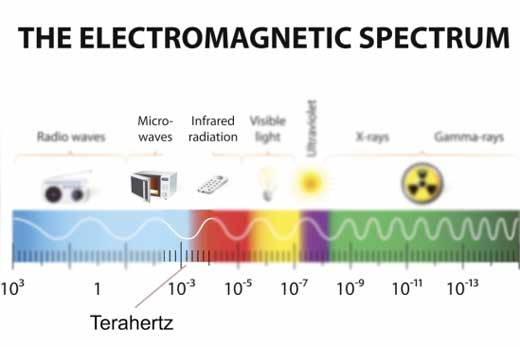| Jan 29, 2020 | |
First successful generation and detection of pure spin currents in antiferromagnetic materials(Nanowerk News) For advanced technologies in applications from imaging to communications, the terahertz region of the electromagnetic spectrum is the place to be. Located between the microwave and infrared regions, the terahertz region is being explored by researchers who seek to understand and utilize its particular capabilities. |
|
| Terahertz waves, for instance, are capable of rapid transmission of large amounts of data, making them a candidate for “beyond 5G” wireless communications. The waves also are highly sensitive, able to see between layers of biological tissue or other fine materials where conventional (and relatively more harmful) x-rays can’t. | |
| Technologies like ultrafast wireless communication use increasing amounts of energy. Spintronics — the use of the “spin” of an electron, rather than its electric charge — is being vigorously investigated as a way to reduce the amount of energy needed to satisfy society’s increasing demand for bandwidth. To help turbocharge spintronics, condensed matter physicists at UC Santa Barbara and UC Riverside have developed a method for terahertz waves to convert spin excitations into electrical signals. | |
| Their work is published in a paper that appears in the journal Nature ("Spin current from sub-terahertz-generated antiferromagnetic magnons"). | |
 |
|
| The terahertz region occupies the border between the microwave and infrared regions of the electromagnetic spectrum. (Image: UCSB) | |
| “This has been an extremely rewarding collaboration that combined UC Riverside’s expertise in spintronic materials and devices with our unique instrumentation for terahertz magnetic resonance,” said physicist Mark Sherwin, who directs the Institute for Terahertz Science and Technology on the UCSB campus, where some of the research was conducted. | |
| The finding is based on a magnetic resonance phenomenon in antiferromagnetic materials. Such materials, also called antiferromagnets, offer unique advantages for ultrafast and spin-based nanoscale device applications. | |
| Led by physicist Jing Shi of UC Riverside, the scientists generated a spin current, an important physical quantity in spintronics, in an antiferromagnet and were able to detect it electrically. To accomplish this feat, they used terahertz radiation to pump up magnetic resonance in chromia (chromic oxide) to facilitate its detection. | |
| In ferromagnets, such as a bar magnet, electron spins point in the same direction, up or down, thus providing collective strength to the materials. In antiferromagnets, the atomic arrangement is such that the electron spins cancel each other out, with half of the spins pointing in the opposite direction of the other half, either up or down. | |
| The electron has a built-in spin angular momentum, which can precess — or change the orientation of its rotational axis — the way a spinning top precesses around a vertical axis. When the precession frequency of electrons matches the frequency of electromagnetic waves generated by an external source acting on the electrons, magnetic resonance occurs and is manifested in the form of a greatly enhanced signal that is easier to detect. | |
| In order to generate such magnetic resonance, the team of physicists from UC Riverside and UC Santa Barbara worked with 0.24 terahertz of radiation produced at the ITST’s Terahertz Facilities. This closely matched the precession frequency of electrons in chromia. The magnetic resonance that followed resulted in the generation of a spin current that the researchers converted into a DC voltage. | |
| “We were able to demonstrate that antiferromagnetic resonance can produce an electrical voltage, a spintronic effect that has never been done experimentally before,” said Shi, adding that subterahertz and terahertz radiation are a challenge to detect. Current communication technology uses gigahertz microwaves. | |
| “For higher bandwidth, however, the trend is to move toward terahertz microwaves,” Shi said. | |
| Although antiferromagnets are statically uninteresting, they are dynamically interesting. Electron spin precession in antiferromagnets is much faster than in ferromagnets, resulting in frequencies that are two to three orders of magnitude higher than the frequencies of ferromagnets — thus allowing faster information transmission. | |
| “Spin dynamics in antiferromagnets occur at a much shorter timescale than in ferromagnets, which offers attractive benefits for potential ultrafast device applications,” Shi said. | |
| Antiferromagnets are ubiquitous and more abundant than ferromagnets. Many ferromagnets, such as iron and cobalt, become antiferromagnetic when oxidized. Many antiferromagnets are good insulators with low dissipation of energy. | |
| Shi’s team developed a bilayer structure comprised of chromia, an antiferromagnetic insulator, with a layer of metal on top to serve as the detector to sense signals from chromia. According to the research, the electrons in chromia remain local. What crosses the interface is information encoded in the precessing spins of the electrons. | |
| The researchers addressed spin sensitivity by focusing on platinum and tantalum as metal detectors. If the signal from chromia originates in spin, platinum and tantalum register the signal with opposite polarity. If the signal is caused by heating, however, both metals register the signal with identical polarity. | |
| The technology is patent pending. |
| Source: UC Santa Barbara | |
|
Subscribe to a free copy of one of our daily Nanowerk Newsletter Email Digests with a compilation of all of the day's news. |
